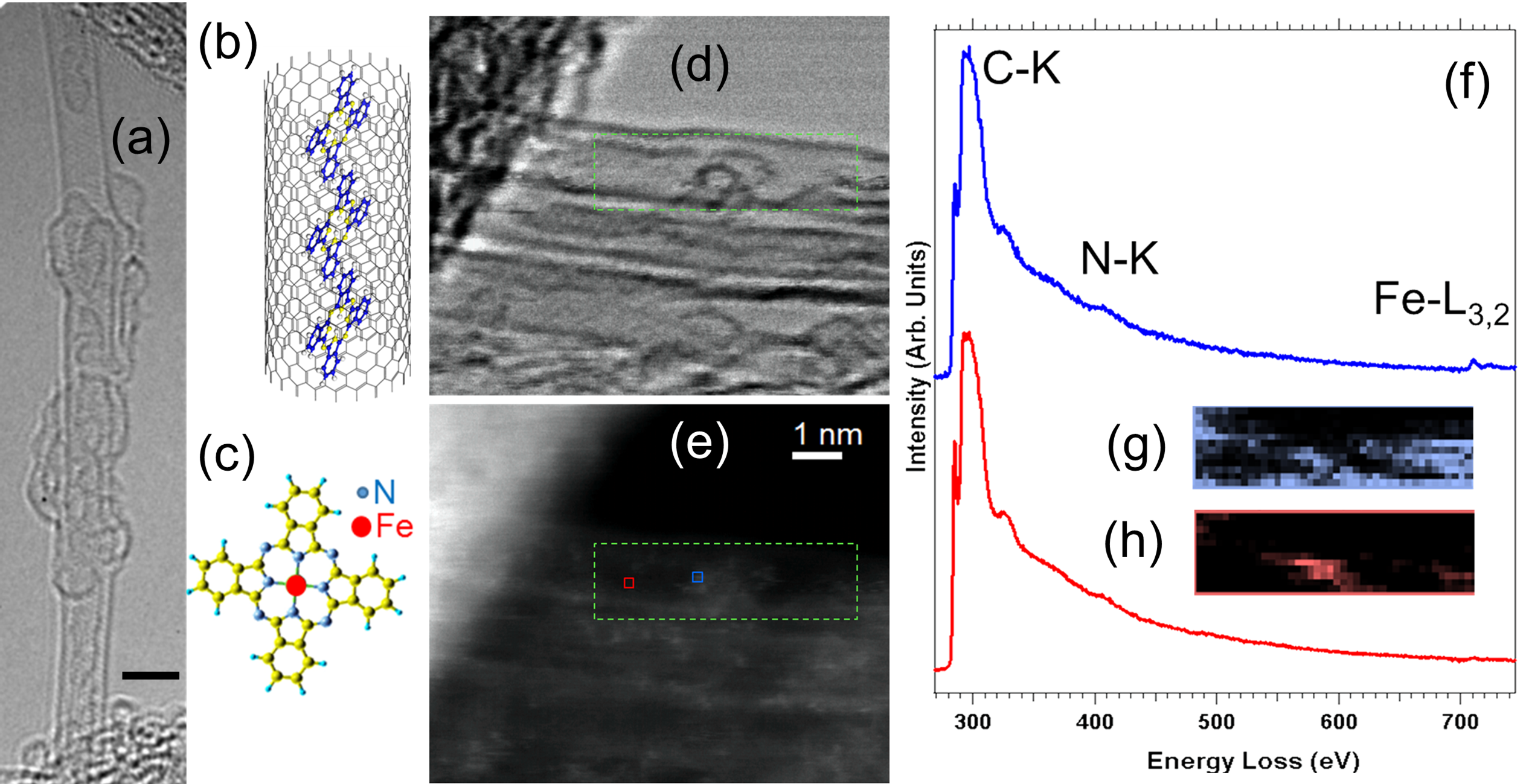Functionalization of Single-Walled Carbon Nanotubes Analyzed by Spatially-Resolved EELS
- Abstract number
- 1235
- Event
- European Microscopy Congress 2020
- DOI
- 10.22443/rms.emc2020.1235
- Corresponding Email
- [email protected]
- Session
- PSA.1 - 1D & 2D Materials
- Authors
- Dr. Raul Arenal (2, 3, 4), Dr. Laurent Alvarez (1), Dr. Jean-Louis Bantignies (1)
- Affiliations
-
1. Laboratoire Charles Coulomb, U. Montpelier - CNRS
2. Laboratorio de Microscopías Avanzadas, Instituto de Nanociencia de Aragón, Universidad de Zaragoza,
3. ARAID Foundation
4. Instituto de Ciencias de Materiales Aragon, CSIC-U. Zaragoza
- Keywords
Carbon - Nanotubes; EELS; Functionalization; Supramolecular order
- Abstract text
Surface functionalization of 1D and 2D nanomaterials is a perfect way for controlling their properties [1-7]. Very detailed structural and chemical composition analyses, at the atomic scale, of such surface modifications are required in order to determine their impact on the electronic/optoelectronic properties. Transmission electron microscopy (TEM) and in particular, spatially-resolved electron energy loss spectroscopy (SR-EELS) developed in an aberration-corrected TEM, is the most powerful technique to get this information. Indeed, having access to a close to 1 angstrom electron probe, the atomic configuration and concentration of the different species of these functionalized nanomaterials can be obtained [1-7].
In this contribution, we report an in-depth study of the atomic configuration of covalent and non-covalent functionalized (pi-stacked and endohedral) single-walled (SW) C-NTs via SR-EELS [1-7]. These studies have been developed via spatially-resolved EELS performed using a liquid-nitrogen holder (−170 °C) and FEI Titan Low-Base microscope, working at 80 kV. This microscope is equipped with a Cs probe corrector and ultra-bright XFEG electron source. The convergent semi-angle was of 25 mrad, the collection semi-angle was of 35 mrad, and the energy resolution was ~1.2 eV. The HRTEM studies have been carried out in a FEI Titan Cubed microscope (equipped with a Cs image corrector), under the same cryogenic conditions (−170 °C) and at 80kV.
We have investigated different systems of functionalized NTs (covalent and non-covalent (endohedral and pi-stacked)), for getting local information about these different hybrid configurations, studying the chemical environment and bonding of the NTs and the organic moieties [2, 5-7]. Fig. 1 illustrates some of these results, in particular the case of endohedral functionalization: iron-phthalocyanine (Fe-Pc) moieties in single-walled nanotubes. Fig. 1 (a) corresponds to a HRTEM image of one of these individual filled single-walled C-NTs. Fig. 1 (b) displays an atomic-sketch, showing the supramolecular order of the Fe-Pc within a SWNT and Fig. 1 (c) shows an atomic-sketch of one of these Fe-Pc molecules (a Fe atom is surrounded by 4 pyrrolic-like subunits). As it is well knows, these NTs tend to be organized in bundles. Figures 1 (d) and (e), which correspond to of STEM (BF and HAADF) micrographs, show one these bundles of SW-CNTs. A 24x12 EELS spectrum-image (SPIM) has been recorded in the green marked area on one of these NT. (f) EEL spectra extracted from the squared regions marked in Fig. 1(e). They correspond to four EEL spectra each of them. C-K, N-K and Fe-L2,3 edges are clearly seen. From these spectra, nitrogen and iron elemental maps can be obtained, see Fig. 1 (g) and (h). These studies reveal the supramolecular organization of the organic moieties (in this present case showed in this figure, iron-phthalocyanines) used for the functionalization of the NTs [7].
In summary, these works provide very rich information about these hybrid and complex nanomaterials, opening fascinating perspectives for optoelectronic applications of such nanosystems. All these aspects will be discussed in this contribution.
Figure 1. (a) HRTEM micrograph of a SW-CNT filled with iron-phthalocyanine (Fe-Pc) moieties. (b) Atomic-sketch showing the supramolecular order of these Fe-Pc entities within a SW-NT. (c) Atomic-sketch of a Fe-Pc (a Fe atom is surrounded by 4 pyrrolic-like subunits. (d)-(e) BF- and HAADF-STEM images of a bundle of filled SWNT. A SPIM-EELS has been recorded in the green marked area. (f) EEL spectra extracted from the squared regions marked in Fig. 1(e). They correspond to 4 EEL spectra each of them. C-K, N-K and Fe-L2,3 edges are clearly seen. (g)-(h) N and Fe elemental maps. [7]
- References
[1] R. Canton-Vitoria, T. Scharl, A. Stergiou, A. Cadranel, R. Arenal, D.M. Guldi, N. Tagmatarchis, Angewandte Chemie Int. (2020).
[2] A. Setaro, M. Adeli, M. Glaeske, D. Przyrembel, T. Bisswanger, G. Gordeev, M. Weinelt, R. Arenal, R. Haag, S. Reich, Nature Comm. 8, 14281 (2017).
[3] L. Vallan, R. Canton-Vitoria, H. Gobeze, Y. Jang, R. Arenal, A. Benito, W. Maser, F. D'Souza, N. Tagmatarchis, J. Am. Chem. Soc., 140, 13488-13496 (2018).
[4] R. Canton-Vitoria, Y. Sayed-Ahmad Baraza, M. Pelaez-Fernandez, R. Arenal, C. Bittencourt, C.P. Ewels, N. Tagmatarchis, Nat. Pub. Gr. 2D Mat. & Appl. 1, 13 (2017).
[5] F. Ernst, Z. Gao, R. Arenal, T. Heek, A. Setaro, R. Fernandez-Pacheco, R. Haag, L. Cognet, S. Reich, J. Phys. Chem. C 121, 18887–18891 (2017).
[6] L. Alvarez, et al., J. Phys. Chem. C 119, 5203–5210 (2015).
[7] R. Arenal, L. Alvarez, J.-L. Bantignies, Submitted.
[8] Research supported by the Spanish MINECO (MAT2016-79776-P, AEI/FEDER, EU), Government of Aragon through project DGA E13_17R (FEDER, EU) and European Union H2020 programs “ESTEEM3” (823717), Graphene Flagship (785219 and 881603) and Flag-ERA GATES (JTC-PCI2018-093137).

